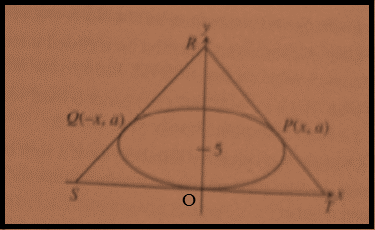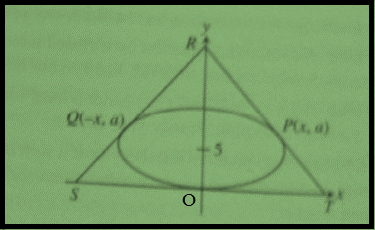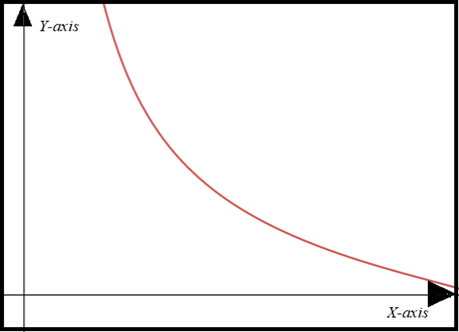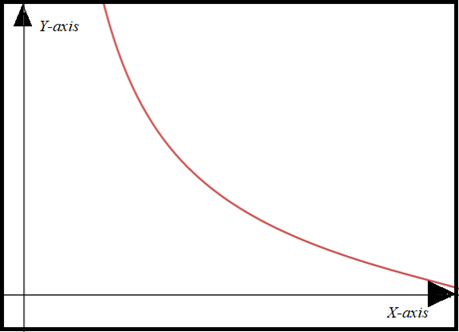
a.
Show that the area of the triangle is
a.
Answer to Problem 65E
Area of triangle
Here,
Explanation of Solution
Given:
Ellipse of equation:
A triangle

Concept Used:
The equation of tangent line that passes through the point
Here,
Calculation:
Rewrite the equation
First Derivative:-
Take
Also,
Slope of ellipse :
Slope of ellipse at point
Take point
As, given that point
Put
Slope: - of ellipse passes through point
The x -intercept of line: -
Since, the value of
For x −intercept put
So,
And the co-ordinates of vertex
And, the distance of
And,
The
Since, the value of
For
So,
And the co-ordinates of vertex
The distance of
Also,
Area:-

Area of triangle
So, Area of triangle
Area of triangle
Area of triangle
Area of triangle
But,
Area of triangle
Put
Area of triangle
Here,
Conclusion:
Area of triangle
Here,
b.
To Find: the domain of
b.
Explanation of Solution
Given:
Area of triangle
Here,
Calculation:
Rewrite the area,
Area of triangle
Here,
Area is defined if
On solving,
So, Domain:
Graph:

Here,
According to graph, the asymptotes of graph does not form triangle as tangent lines formed in given problem.
The vertical asymptote is
c.
Find the height of the triangle with minimum area.
Also, check if it is related to the y-coordinate of the center of the ellipse.
c.
Answer to Problem 65E
Height
Also, height is related to the y-coordinate of the center of the ellipse. It is the triple time of the y-coordinate of the center of the ellipse.
Explanation of Solution
Given:
Area of triangle
Here,
Calculation:
Differentiate the
For point of minima put
Height
Put the value and solve,
Height
Conclusion:
Height
Also, height is related to the y-coordinate of the center of the ellipse. It is the triple time of the y-coordinate of the center of the ellipse.
d.
Repeat the part (a) to (c) for the ellipse
d.
Answer to Problem 65E
Area of triangle
Domain:
Explanation of Solution
Given:
From part (a)
Area of triangle
Here,
Calculation:
Solve in the same way as part (a), (b) and (c).
Area of triangle
Here,
Domain:
Since, Graph Is same for both parts. So,
Graph:

Here,
Chapter 4 Solutions
CALCULUS-W/XL ACCESS
- T 1 7. Fill in the blanks to write the calculus problem that would result in the following integral (do not evaluate the interval). Draw a graph representing the problem. So π/2 2 2πxcosx dx Find the volume of the solid obtained when the region under the curve on the interval is rotated about the axis.arrow_forward38,189 5. Draw a detailed graph to and set up, but do not evaluate, an integral for the volume of the solid obtained by rotating the region bounded by the curve: y = cos²x_for_ |x| ≤ and the curve y y = about the line x = =플 2 80 F3 a FEB 9 2 7 0 MacBook Air 3 2 stv DGarrow_forwardFind f(x) and g(x) such that h(x) = (fog)(x) and g(x) = 3 - 5x. h(x) = (3 –5x)3 – 7(3 −5x)2 + 3(3 −5x) – 1 - - - f(x) = ☐arrow_forward
- x-4 Let f(x)=5x-1, h(x) = Find (fo h)(0). 3 (fo h)(0) = (Type an integer or a fraction.)arrow_forwardFill in the blanks to write the calculus problem that would result in the following integral (do not evaluate the interval). Draw a graph representing the problem. π/2 So/² 2xcosx dx Find the volume of the solid obtained when the region under the curve 38,189 on the interval is rotated about the axis.arrow_forwardLet f(x) = -5x-1, g(x) = x² + 5, h(x) = · x+4 3 Find (hog of)(1). (hogof)(1)= (Simplify your answer. Type an integer or a decimal.)arrow_forward
- For the given function, find (a) the equation of the secant line through the points where x has the given values and (b) the equation of the tangent line when x has the first value. y= f(x) = x²+x; x=-1,x=2 a. Which of the following formulas can be used to find the slope of the secant line? ○ A. 2-(-1) f(2) f(-1) 2+(-1) C. 1(2)+(-1) The equation of the secant line is 1(2)+(-1) О в. 2+(-1) f(2)-(-1) D. 2-(-1)arrow_forwardplease do not use chat gptarrow_forwardUse technology to find f'(4), f'(16), f'(-5) for the given function when the derivative exists. f(x) = -2x² + +10xarrow_forward
 Calculus: Early TranscendentalsCalculusISBN:9781285741550Author:James StewartPublisher:Cengage Learning
Calculus: Early TranscendentalsCalculusISBN:9781285741550Author:James StewartPublisher:Cengage Learning Thomas' Calculus (14th Edition)CalculusISBN:9780134438986Author:Joel R. Hass, Christopher E. Heil, Maurice D. WeirPublisher:PEARSON
Thomas' Calculus (14th Edition)CalculusISBN:9780134438986Author:Joel R. Hass, Christopher E. Heil, Maurice D. WeirPublisher:PEARSON Calculus: Early Transcendentals (3rd Edition)CalculusISBN:9780134763644Author:William L. Briggs, Lyle Cochran, Bernard Gillett, Eric SchulzPublisher:PEARSON
Calculus: Early Transcendentals (3rd Edition)CalculusISBN:9780134763644Author:William L. Briggs, Lyle Cochran, Bernard Gillett, Eric SchulzPublisher:PEARSON Calculus: Early TranscendentalsCalculusISBN:9781319050740Author:Jon Rogawski, Colin Adams, Robert FranzosaPublisher:W. H. Freeman
Calculus: Early TranscendentalsCalculusISBN:9781319050740Author:Jon Rogawski, Colin Adams, Robert FranzosaPublisher:W. H. Freeman
 Calculus: Early Transcendental FunctionsCalculusISBN:9781337552516Author:Ron Larson, Bruce H. EdwardsPublisher:Cengage Learning
Calculus: Early Transcendental FunctionsCalculusISBN:9781337552516Author:Ron Larson, Bruce H. EdwardsPublisher:Cengage Learning





